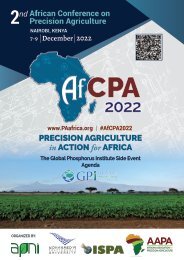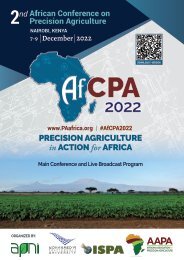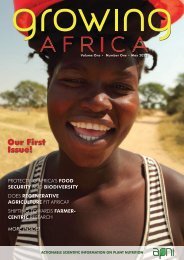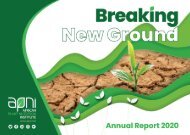APNI Annual Report 2022 - Towards Transformation
You also want an ePaper? Increase the reach of your titles
YUMPU automatically turns print PDFs into web optimized ePapers that Google loves.
BIBLIOGRAPHY<br />
PEER-REVIEWED ARTICLES<br />
1. W. Ntinyari, J. Gweyi-Onyango, M. Giweta,<br />
J. Mutegi, B. Mochoge, G. Nziguheba, and C.<br />
Masso <strong>2022</strong>. Nitrogen budgets and nitrogen<br />
use efficiency as agricultural performance<br />
indicators in Lake Victoria basin. Front.<br />
Sustain. Food Syst. 6:1023579.<br />
http://doi.org/10.3389/fsufs.<strong>2022</strong>.1023579<br />
A key outcome of the study is the authors<br />
contribution to the definition of critical N<br />
boundaries for food production systems in<br />
the basin through their definition of three<br />
distinct zones for safe (soil sustaining)<br />
operation, inefficient use of available N,<br />
and soil mining. Continued movement<br />
towards, and beyond, the Abuja 2006<br />
target for N application is required to<br />
support food sufficiency and optimal use<br />
of N fertilizer inputs.<br />
Our study is intended to help inform<br />
future policy on the changes of N<br />
“<br />
management required to form adequate<br />
recommendations for farmers, and to<br />
achieve desired goals for sustainability<br />
and regional food security.<br />
Ntinyari et al. <strong>2022</strong>. Front. Sustain. Food Syst.<br />
2. S.P. Singh, S. Dutta, S. Jha, S.S. Prasad, S.K.<br />
Chaudhary, M.C. Manna, K. Majumdar, P.<br />
Srivastava, P.S. Brahmanand, K.M. Singh, K.<br />
Kumar. <strong>2022</strong>. Indigenous Nutrient Supplying<br />
Capacity of Young Alluvial Calcareous Soils<br />
Favours the Sustainable Productivity of Hybrid<br />
Rice and Maize Crops. Sustainability 14, 11585.<br />
https://doi.org/10.3390/su141811585<br />
3. E. Mugi-Ngenga, L. Bastiaans, S. Zingore, N.P.R.<br />
Anten, K.E. Giller. <strong>2022</strong>. The role of nitrogen<br />
fixation and crop N dynamics on performance<br />
and legacy effects of maize-grain legumes<br />
intercrops on smallholder farms in Tanzania.<br />
Eur. J. Agron. 141, 126617.<br />
https://doi.org/10.1016/j.eja.<strong>2022</strong>.126617<br />
4. S. Zingore, I.S. Adolwa, S. Njoroge, J.-M. Johnson,<br />
K. Saito, S. Phillips, J. Kihara, J. Mutegi, S. Murell,<br />
S. Dutta, P. Chivenge, K.A. Amouzou, T. Oberthür,<br />
S. Chakraborty, G. Weldesemayat Sileshi. <strong>2022</strong>.<br />
Novel insights into factors associated with<br />
yield response and nutrient use efficiency of<br />
maize and rice in sub-Saharan Africa. A review.<br />
Agron. Sust. Devel. 42:82.<br />
https://doi.org/10.1007/s13593-022-00821-4<br />
Ultimately, the team was searching<br />
“<br />
for actionable information to improve<br />
nutrient management for sustainable<br />
crop production intensification in SSA<br />
and identify future nutrient management<br />
research and development priorities<br />
that can help breakthrough existing<br />
knowledge gaps that are preventing yield<br />
improvement at scale. The results of the<br />
analysis provide valuable insights into<br />
the role of balanced fertilizer in improving<br />
the performance of cropping systems<br />
as the continent prepares for the Africa<br />
Union-led 2023 Africa Fertilizer and Soil<br />
Health Summit.<br />
Zingore, S. et al. <strong>2022</strong>. Agron. Sust. Devel.<br />
5. E. Mugi-Ngenga, L. Bastiaans, N.P.R. Anten,<br />
S. Zingore, K.E. Giller. <strong>2022</strong>. Immediate and<br />
residual-effects of sole and intercropped grain<br />
legumes in maize production systems under<br />
rain-fed conditions of Northern Tanzania. Field<br />
Crops Res. 87.<br />
https://doi.org/10.1016/j.fcr.<strong>2022</strong>.108656<br />
6. C.I. Ludemann, R. Hijbeek, M.P. van Loon, T.S.<br />
Murrell, A. Dobermann. M.K. van Ittersum. <strong>2022</strong>.<br />
Estimating maize harvest index and nitrogen<br />
concentrations in grain and residue using<br />
globally available data. Field Crops Res. 284.<br />
https://doi.org/10.1016/j.fcr.<strong>2022</strong>.108578<br />
7. W. Ntinyari, M. Giweta, J. Gweyi-Onyango, B.<br />
Mochoge, J. Mutegi, G. Nziguheba, C. Masso.<br />
<strong>2022</strong>. Assessment of the 2006 Abuja Fertilizer<br />
Declaration with Emphasis on Nitrogen Use<br />
Efficiency to Reduce Yield Gaps in Maize<br />
Production. Frontiers in Sust. Food Syst. 5,<br />
https://doi.org/10.3389/fsufs.2021.758724<br />
8. J. Wellens, D. Raes, E. Fereres, J. Diels, C.<br />
Coppye, J.G. Adiele, K.S.G. Ezui, L.-A. Becerra,<br />
M.G. Selvaraj, G. Dercon, L. Kheng Heng.<br />
<strong>2022</strong>. Calibration and validation of the<br />
FAO AquaCrop water productivity model<br />
for cassava (Manihot esculenta Crantz).<br />
Agricultural Water Management 263, pp.<br />
107491,<br />
https://doi.org/10.1016/j.agwat.<strong>2022</strong>.107491<br />
9. J.P. Monzon, M. Jabloun, J. Cock, J-P Calman, A.<br />
Couëdel, P. Ho Vun Vui, C.R. Donough, Y.L. Lim, J.<br />
Mathews, T. Oberthür, N.E. Prabowo, J.I. Rattalino<br />
Edreira, M. Sidhu, M.A. Slingerland, H. Sugianto,<br />
P. Grassini. <strong>2022</strong>. Influence of weather and<br />
endogenous cycles on spatiotemporal yield<br />
variation in oil palm. Agricultural and Forest<br />
Meteorology 314, pp. 108789,<br />
https://doi.org/10.1016/j.agrformet.2021.108789<br />
10. W. Ntinyari, J. Gweyi-Onyango, M. Giweta, B.<br />
Mochoge, J. Mutegi, G. Nziguheba, C. Masso.<br />
<strong>2022</strong>. Nitrogen use efficiency trends for<br />
sustainable crop productivity in Lake Victoria<br />
basin: smallholder farmers’ perspectives on<br />
nitrogen cycling, Environmental Research<br />
Communications 4, pp. 015004,<br />
https://doi.org/10.1088/2515-7620/ac40f2<br />
11. P. Chivenge, S. Zingore, K.S. Ezui, S. Njoroge,<br />
M.A. Bunquin, A. Dobermann, K. Saito. <strong>2022</strong>.<br />
Progress in research on site-specific nutrient<br />
management for smallholder farmers in sub-<br />
Saharan Africa. Field Crops Res. 281, 108503.<br />
https://doi.org/10.1016/j.fcr.<strong>2022</strong>.108503<br />
“<br />
The review’s consolidation of<br />
data from SSNM experimentation<br />
for the three crops over 30 years<br />
demonstrates<br />
…greater yield, N use efficiency and<br />
gross return above fertilizer cost<br />
benefits when SSNM was compared<br />
with the farmer practice …or blanket<br />
recommendations.<br />
More expertise in the development<br />
and support of farmer-friendly, digital<br />
support tools is also required to break<br />
through barriers to their acceptance.<br />
Also, concerted effort needs to be<br />
directed towards experimentation<br />
and extension programs that work<br />
alongside farmers to ensure SSNM<br />
interventions are supported by other<br />
key sets of improvement in on-farm<br />
agronomy.<br />
Chivenge, P. et al., <strong>2022</strong>. Field Crops<br />
Res.<br />
12. K. Majumdar, S. Zingore, P. Chivenge, S. Dutta.<br />
<strong>2022</strong>. Sustainable intensification: balancing<br />
the acts. Indian J. Agron. 66 (5th IAC Special<br />
issue).<br />
64








